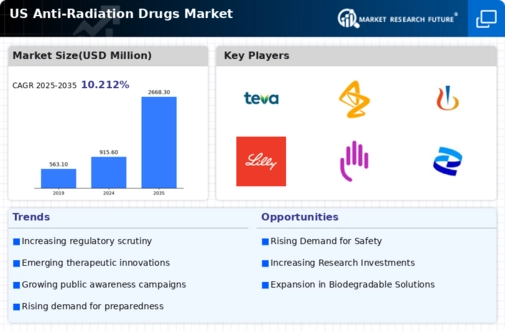Growing Awareness of Radiation Risks
The increasing awareness of radiation exposure risks among the general public and healthcare professionals is a key driver for the anti radiation-drugs market. As incidents of radiation exposure, whether from medical procedures or environmental sources, become more widely recognized, the demand for effective anti radiation drugs is likely to rise. Educational campaigns and media coverage have contributed to this heightened awareness, prompting individuals to seek preventive measures. This trend is reflected in market data, which indicates a projected growth rate of approximately 8% annually in the anti radiation-drugs market. The industry is responding by developing innovative solutions to mitigate radiation effects, thereby enhancing the overall market landscape.
Rising Incidence of Cancer Treatments
The rising incidence of cancer treatments, particularly those involving radiation therapy, is a significant driver for the anti radiation-drugs market. As more patients undergo radiation therapy, the need for drugs that can mitigate the side effects of radiation exposure becomes increasingly critical. The anti radiation-drugs market is responding to this demand by developing supportive care medications that can enhance patient outcomes. Market analysis indicates that the segment related to cancer treatment is expected to grow at a rate of 10% annually, reflecting the urgent need for effective anti radiation solutions. This trend underscores the importance of integrating anti radiation drugs into comprehensive cancer care protocols.
Advancements in Pharmaceutical Research
Recent advancements in pharmaceutical research are significantly influencing the anti radiation-drugs market. The development of novel compounds and drug delivery systems has opened new avenues for effective radiation protection and treatment. Research institutions and pharmaceutical companies are increasingly collaborating to explore new therapeutic agents that can counteract radiation damage. This collaborative effort is expected to drive market growth, with estimates suggesting that the market could reach $1 billion by 2027. The anti radiation-drugs market is witnessing a surge in clinical trials aimed at validating the efficacy of these new drugs, which may lead to a broader acceptance and utilization in clinical settings.
Regulatory Support for Drug Development
Regulatory support for the development of anti radiation drugs is emerging as a crucial driver in the market. Government agencies are recognizing the need for effective countermeasures against radiation exposure, particularly in the context of nuclear incidents and medical applications. Initiatives aimed at expediting the approval process for anti radiation drugs are likely to enhance market dynamics. The anti radiation-drugs market benefits from streamlined regulatory pathways, which can reduce time-to-market for new products. This regulatory environment is expected to foster innovation and encourage investment in research and development, potentially leading to a more robust market presence.
Increased Military and Defense Investments
The anti radiation-drugs market is experiencing growth due to increased investments in military and defense sectors. As geopolitical tensions rise, there is a heightened focus on protecting military personnel from potential radiation exposure during conflicts or nuclear incidents. This has led to increased funding for research and development of anti radiation drugs tailored for military applications. The market is projected to expand as defense agencies seek effective solutions to safeguard their personnel. The anti radiation-drugs market is likely to see a surge in demand for specialized formulations that can be rapidly deployed in emergency situations, further driving market growth.

















Leave a Comment